Strategic Analysis of Tesco Plc: Past Strategies and Future Direction
VerifiedAdded on 2020/11/12
|19
|4425
|159
Report
AI Summary
This report offers a comprehensive strategic analysis of Tesco Plc, a leading UK retail supermarket. It begins with an overview of Tesco's past strategic direction, focusing on its customer-centric approach and the application of Porter's generic strategies (cost leadership, cost focus, and differentiation focus). The report then delves into an external analysis of the UK retail industry using the PESTLE framework, considering political, economic, social, technological, legal, and environmental factors. A competitive analysis is conducted using Porter's Five Forces model, assessing the bargaining power of buyers and suppliers, the threat of substitutes and new entrants, and industry rivalry. The report then examines the concept of strategic drift in the context of Tesco, analyzing the phases of incremental change, strategic drift, flux, and transformational change. The report concludes with an examination of Tesco's mission and vision statements and recommendations for future strategies to enhance its competitive advantage. This analysis is intended to provide insights into Tesco's past and present strategies and to recommend ways for the company to adapt and thrive in a dynamic market environment. The report uses various models and frameworks to provide a detailed and comprehensive analysis.
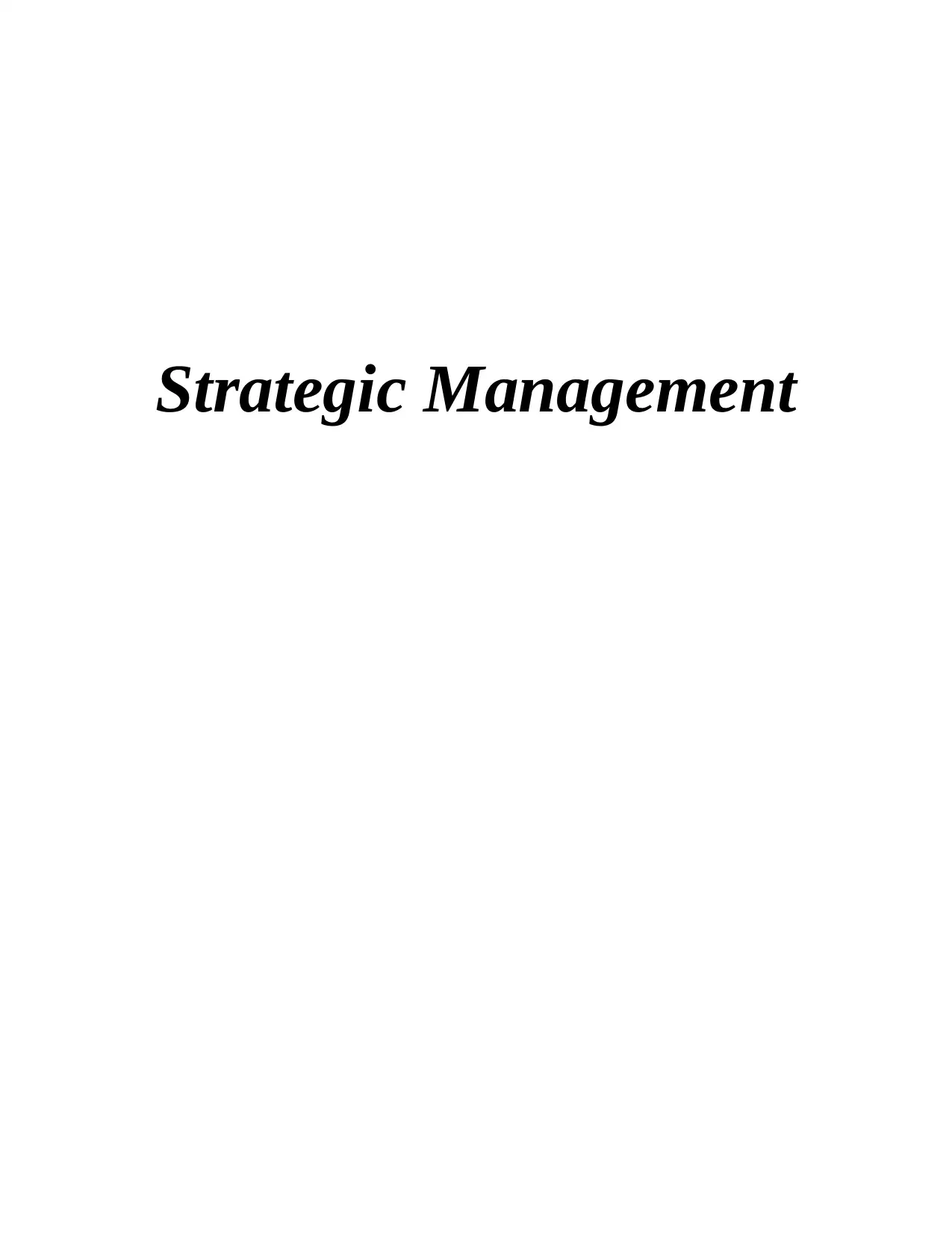
Strategic Management
Paraphrase This Document
Need a fresh take? Get an instant paraphrase of this document with our AI Paraphraser
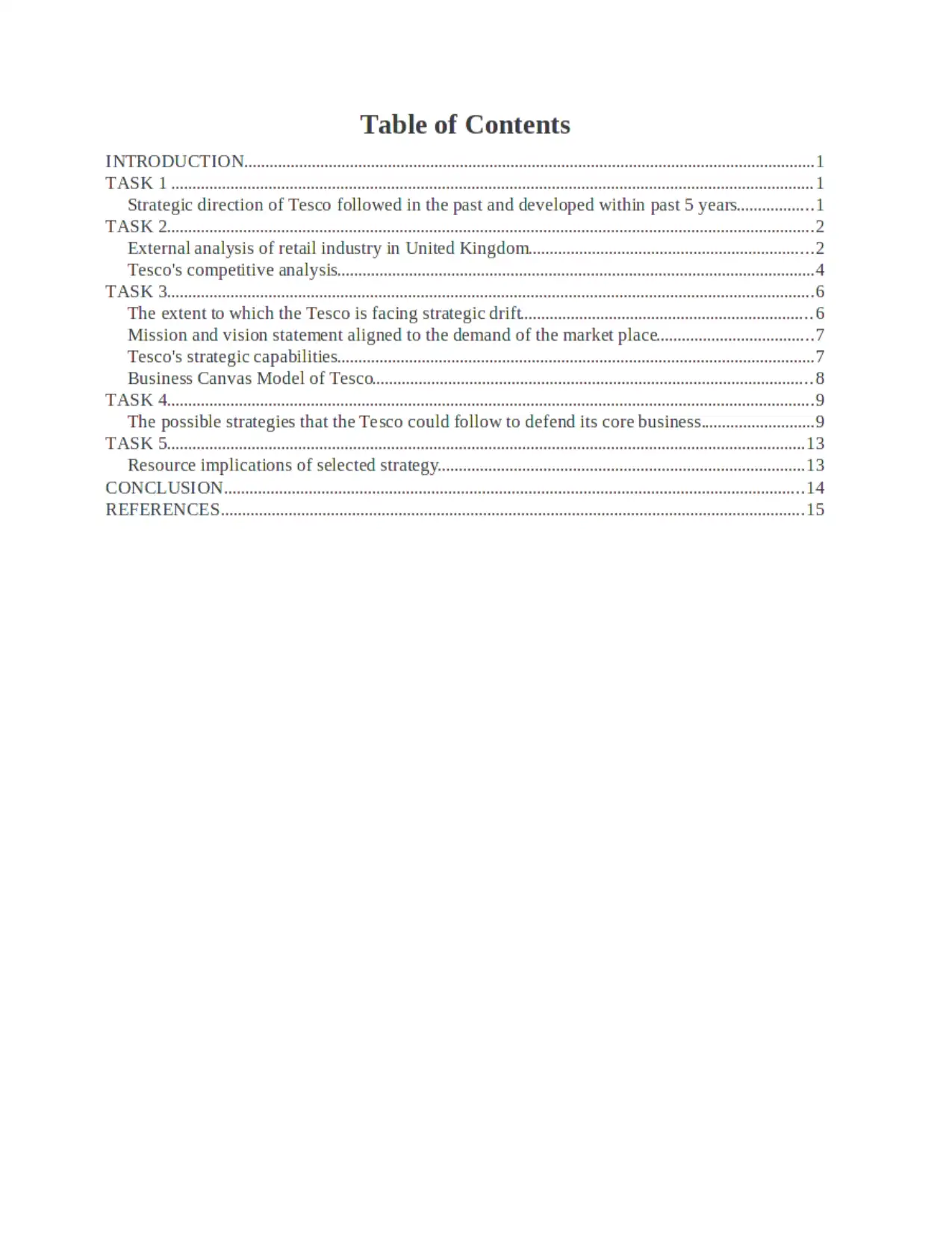
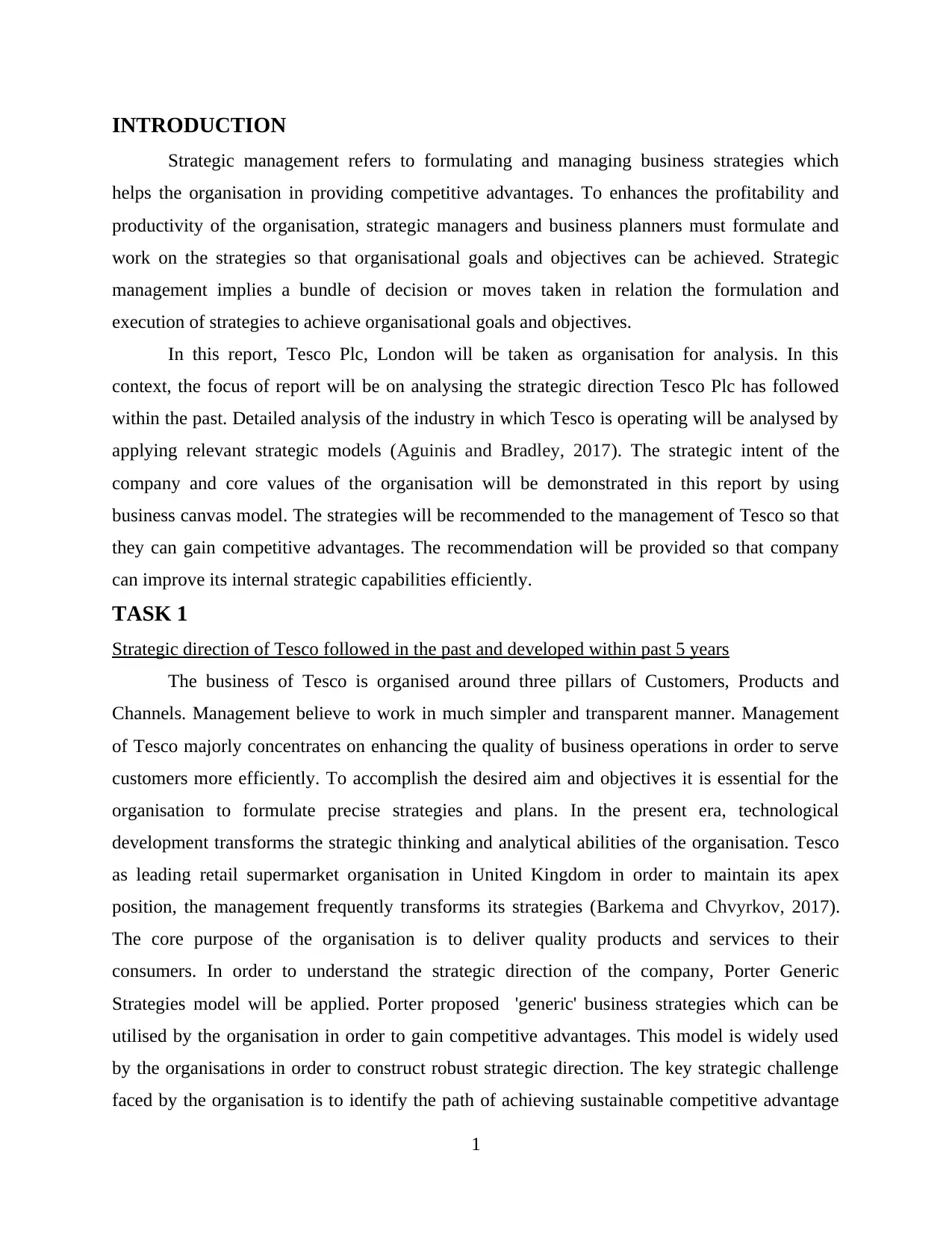
INTRODUCTION
Strategic management refers to formulating and managing business strategies which
helps the organisation in providing competitive advantages. To enhances the profitability and
productivity of the organisation, strategic managers and business planners must formulate and
work on the strategies so that organisational goals and objectives can be achieved. Strategic
management implies a bundle of decision or moves taken in relation the formulation and
execution of strategies to achieve organisational goals and objectives.
In this report, Tesco Plc, London will be taken as organisation for analysis. In this
context, the focus of report will be on analysing the strategic direction Tesco Plc has followed
within the past. Detailed analysis of the industry in which Tesco is operating will be analysed by
applying relevant strategic models (Aguinis and Bradley, 2017). The strategic intent of the
company and core values of the organisation will be demonstrated in this report by using
business canvas model. The strategies will be recommended to the management of Tesco so that
they can gain competitive advantages. The recommendation will be provided so that company
can improve its internal strategic capabilities efficiently.
TASK 1
Strategic direction of Tesco followed in the past and developed within past 5 years
The business of Tesco is organised around three pillars of Customers, Products and
Channels. Management believe to work in much simpler and transparent manner. Management
of Tesco majorly concentrates on enhancing the quality of business operations in order to serve
customers more efficiently. To accomplish the desired aim and objectives it is essential for the
organisation to formulate precise strategies and plans. In the present era, technological
development transforms the strategic thinking and analytical abilities of the organisation. Tesco
as leading retail supermarket organisation in United Kingdom in order to maintain its apex
position, the management frequently transforms its strategies (Barkema and Chvyrkov, 2017).
The core purpose of the organisation is to deliver quality products and services to their
consumers. In order to understand the strategic direction of the company, Porter Generic
Strategies model will be applied. Porter proposed 'generic' business strategies which can be
utilised by the organisation in order to gain competitive advantages. This model is widely used
by the organisations in order to construct robust strategic direction. The key strategic challenge
faced by the organisation is to identify the path of achieving sustainable competitive advantage
1
Strategic management refers to formulating and managing business strategies which
helps the organisation in providing competitive advantages. To enhances the profitability and
productivity of the organisation, strategic managers and business planners must formulate and
work on the strategies so that organisational goals and objectives can be achieved. Strategic
management implies a bundle of decision or moves taken in relation the formulation and
execution of strategies to achieve organisational goals and objectives.
In this report, Tesco Plc, London will be taken as organisation for analysis. In this
context, the focus of report will be on analysing the strategic direction Tesco Plc has followed
within the past. Detailed analysis of the industry in which Tesco is operating will be analysed by
applying relevant strategic models (Aguinis and Bradley, 2017). The strategic intent of the
company and core values of the organisation will be demonstrated in this report by using
business canvas model. The strategies will be recommended to the management of Tesco so that
they can gain competitive advantages. The recommendation will be provided so that company
can improve its internal strategic capabilities efficiently.
TASK 1
Strategic direction of Tesco followed in the past and developed within past 5 years
The business of Tesco is organised around three pillars of Customers, Products and
Channels. Management believe to work in much simpler and transparent manner. Management
of Tesco majorly concentrates on enhancing the quality of business operations in order to serve
customers more efficiently. To accomplish the desired aim and objectives it is essential for the
organisation to formulate precise strategies and plans. In the present era, technological
development transforms the strategic thinking and analytical abilities of the organisation. Tesco
as leading retail supermarket organisation in United Kingdom in order to maintain its apex
position, the management frequently transforms its strategies (Barkema and Chvyrkov, 2017).
The core purpose of the organisation is to deliver quality products and services to their
consumers. In order to understand the strategic direction of the company, Porter Generic
Strategies model will be applied. Porter proposed 'generic' business strategies which can be
utilised by the organisation in order to gain competitive advantages. This model is widely used
by the organisations in order to construct robust strategic direction. The key strategic challenge
faced by the organisation is to identify the path of achieving sustainable competitive advantage
1
⊘ This is a preview!⊘
Do you want full access?
Subscribe today to unlock all pages.

Trusted by 1+ million students worldwide
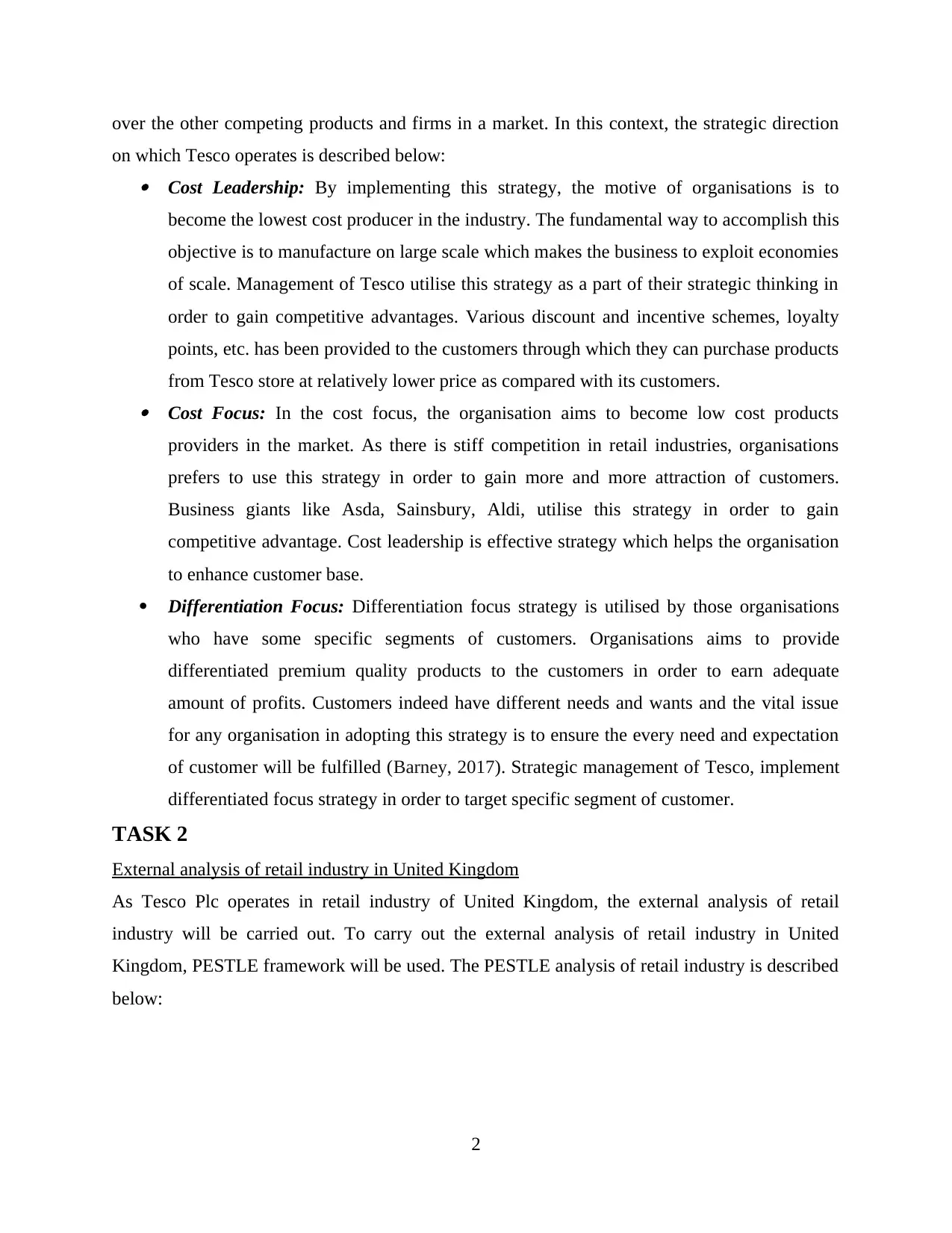
over the other competing products and firms in a market. In this context, the strategic direction
on which Tesco operates is described below: Cost Leadership: By implementing this strategy, the motive of organisations is to
become the lowest cost producer in the industry. The fundamental way to accomplish this
objective is to manufacture on large scale which makes the business to exploit economies
of scale. Management of Tesco utilise this strategy as a part of their strategic thinking in
order to gain competitive advantages. Various discount and incentive schemes, loyalty
points, etc. has been provided to the customers through which they can purchase products
from Tesco store at relatively lower price as compared with its customers. Cost Focus: In the cost focus, the organisation aims to become low cost products
providers in the market. As there is stiff competition in retail industries, organisations
prefers to use this strategy in order to gain more and more attraction of customers.
Business giants like Asda, Sainsbury, Aldi, utilise this strategy in order to gain
competitive advantage. Cost leadership is effective strategy which helps the organisation
to enhance customer base.
Differentiation Focus: Differentiation focus strategy is utilised by those organisations
who have some specific segments of customers. Organisations aims to provide
differentiated premium quality products to the customers in order to earn adequate
amount of profits. Customers indeed have different needs and wants and the vital issue
for any organisation in adopting this strategy is to ensure the every need and expectation
of customer will be fulfilled (Barney, 2017). Strategic management of Tesco, implement
differentiated focus strategy in order to target specific segment of customer.
TASK 2
External analysis of retail industry in United Kingdom
As Tesco Plc operates in retail industry of United Kingdom, the external analysis of retail
industry will be carried out. To carry out the external analysis of retail industry in United
Kingdom, PESTLE framework will be used. The PESTLE analysis of retail industry is described
below:
2
on which Tesco operates is described below: Cost Leadership: By implementing this strategy, the motive of organisations is to
become the lowest cost producer in the industry. The fundamental way to accomplish this
objective is to manufacture on large scale which makes the business to exploit economies
of scale. Management of Tesco utilise this strategy as a part of their strategic thinking in
order to gain competitive advantages. Various discount and incentive schemes, loyalty
points, etc. has been provided to the customers through which they can purchase products
from Tesco store at relatively lower price as compared with its customers. Cost Focus: In the cost focus, the organisation aims to become low cost products
providers in the market. As there is stiff competition in retail industries, organisations
prefers to use this strategy in order to gain more and more attraction of customers.
Business giants like Asda, Sainsbury, Aldi, utilise this strategy in order to gain
competitive advantage. Cost leadership is effective strategy which helps the organisation
to enhance customer base.
Differentiation Focus: Differentiation focus strategy is utilised by those organisations
who have some specific segments of customers. Organisations aims to provide
differentiated premium quality products to the customers in order to earn adequate
amount of profits. Customers indeed have different needs and wants and the vital issue
for any organisation in adopting this strategy is to ensure the every need and expectation
of customer will be fulfilled (Barney, 2017). Strategic management of Tesco, implement
differentiated focus strategy in order to target specific segment of customer.
TASK 2
External analysis of retail industry in United Kingdom
As Tesco Plc operates in retail industry of United Kingdom, the external analysis of retail
industry will be carried out. To carry out the external analysis of retail industry in United
Kingdom, PESTLE framework will be used. The PESTLE analysis of retail industry is described
below:
2
Paraphrase This Document
Need a fresh take? Get an instant paraphrase of this document with our AI Paraphraser
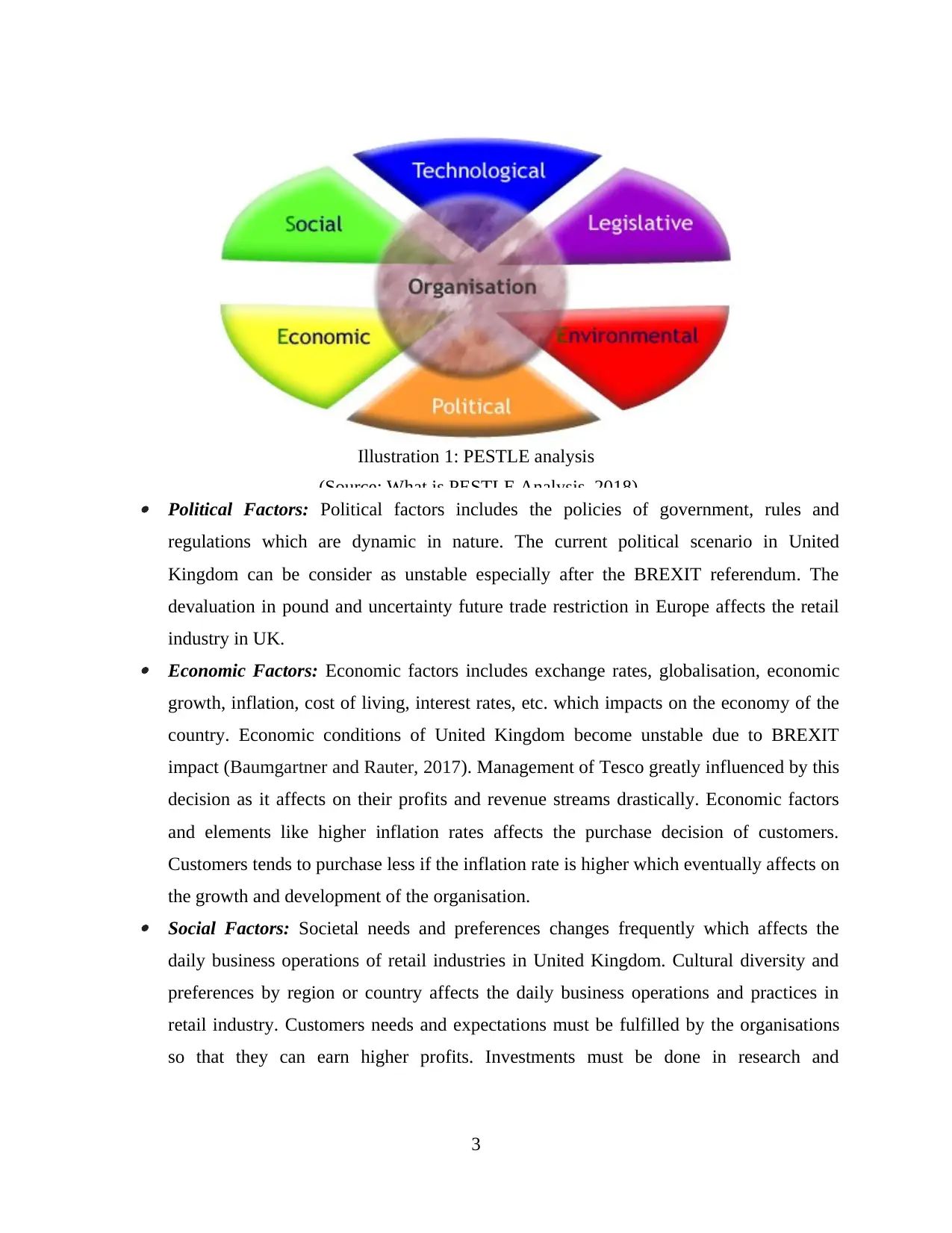
Political Factors: Political factors includes the policies of government, rules and
regulations which are dynamic in nature. The current political scenario in United
Kingdom can be consider as unstable especially after the BREXIT referendum. The
devaluation in pound and uncertainty future trade restriction in Europe affects the retail
industry in UK. Economic Factors: Economic factors includes exchange rates, globalisation, economic
growth, inflation, cost of living, interest rates, etc. which impacts on the economy of the
country. Economic conditions of United Kingdom become unstable due to BREXIT
impact (Baumgartner and Rauter, 2017). Management of Tesco greatly influenced by this
decision as it affects on their profits and revenue streams drastically. Economic factors
and elements like higher inflation rates affects the purchase decision of customers.
Customers tends to purchase less if the inflation rate is higher which eventually affects on
the growth and development of the organisation. Social Factors: Societal needs and preferences changes frequently which affects the
daily business operations of retail industries in United Kingdom. Cultural diversity and
preferences by region or country affects the daily business operations and practices in
retail industry. Customers needs and expectations must be fulfilled by the organisations
so that they can earn higher profits. Investments must be done in research and
3
Illustration 1: PESTLE analysis
(Source: What is PESTLE Analysis, 2018)
regulations which are dynamic in nature. The current political scenario in United
Kingdom can be consider as unstable especially after the BREXIT referendum. The
devaluation in pound and uncertainty future trade restriction in Europe affects the retail
industry in UK. Economic Factors: Economic factors includes exchange rates, globalisation, economic
growth, inflation, cost of living, interest rates, etc. which impacts on the economy of the
country. Economic conditions of United Kingdom become unstable due to BREXIT
impact (Baumgartner and Rauter, 2017). Management of Tesco greatly influenced by this
decision as it affects on their profits and revenue streams drastically. Economic factors
and elements like higher inflation rates affects the purchase decision of customers.
Customers tends to purchase less if the inflation rate is higher which eventually affects on
the growth and development of the organisation. Social Factors: Societal needs and preferences changes frequently which affects the
daily business operations of retail industries in United Kingdom. Cultural diversity and
preferences by region or country affects the daily business operations and practices in
retail industry. Customers needs and expectations must be fulfilled by the organisations
so that they can earn higher profits. Investments must be done in research and
3
Illustration 1: PESTLE analysis
(Source: What is PESTLE Analysis, 2018)
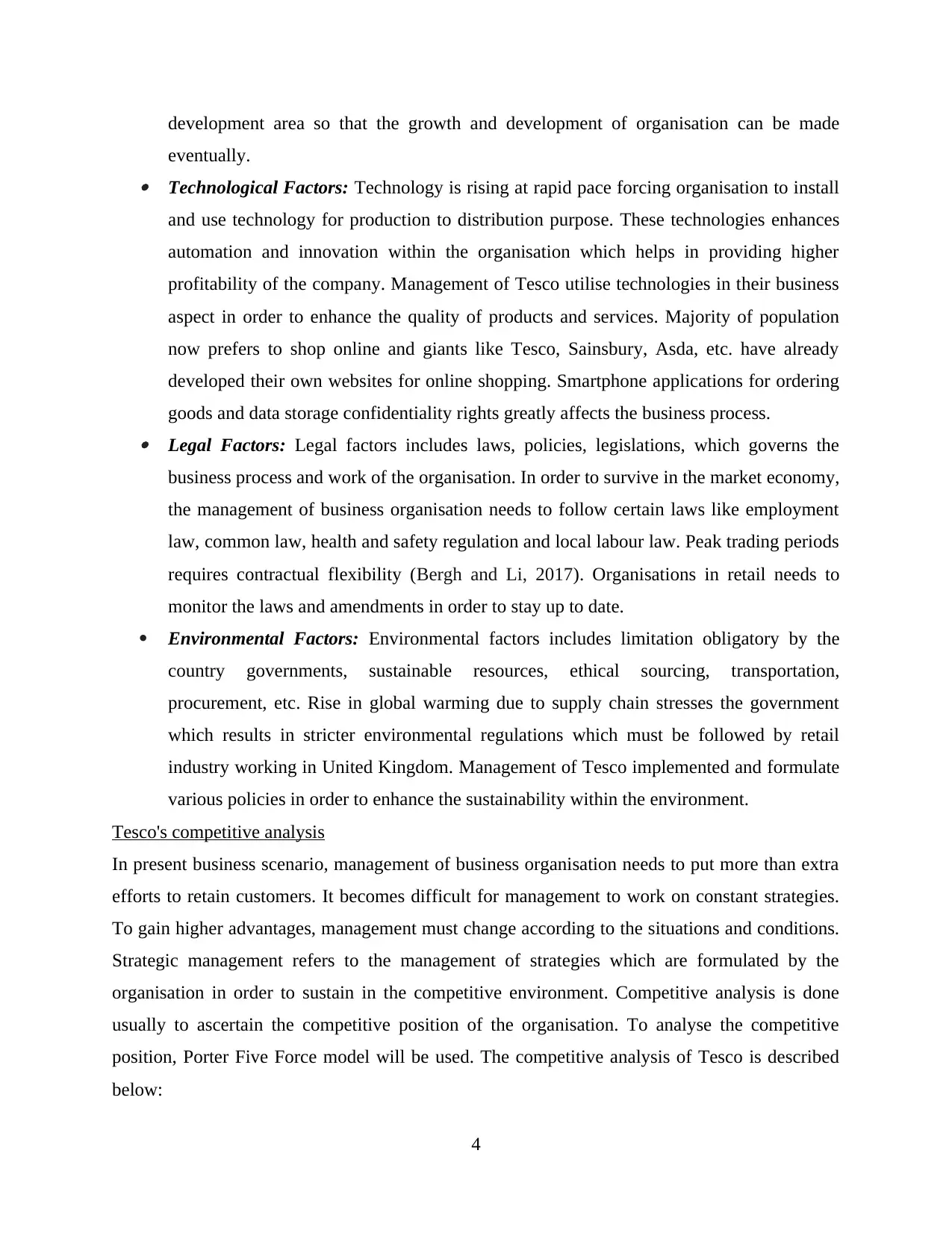
development area so that the growth and development of organisation can be made
eventually. Technological Factors: Technology is rising at rapid pace forcing organisation to install
and use technology for production to distribution purpose. These technologies enhances
automation and innovation within the organisation which helps in providing higher
profitability of the company. Management of Tesco utilise technologies in their business
aspect in order to enhance the quality of products and services. Majority of population
now prefers to shop online and giants like Tesco, Sainsbury, Asda, etc. have already
developed their own websites for online shopping. Smartphone applications for ordering
goods and data storage confidentiality rights greatly affects the business process. Legal Factors: Legal factors includes laws, policies, legislations, which governs the
business process and work of the organisation. In order to survive in the market economy,
the management of business organisation needs to follow certain laws like employment
law, common law, health and safety regulation and local labour law. Peak trading periods
requires contractual flexibility (Bergh and Li, 2017). Organisations in retail needs to
monitor the laws and amendments in order to stay up to date.
Environmental Factors: Environmental factors includes limitation obligatory by the
country governments, sustainable resources, ethical sourcing, transportation,
procurement, etc. Rise in global warming due to supply chain stresses the government
which results in stricter environmental regulations which must be followed by retail
industry working in United Kingdom. Management of Tesco implemented and formulate
various policies in order to enhance the sustainability within the environment.
Tesco's competitive analysis
In present business scenario, management of business organisation needs to put more than extra
efforts to retain customers. It becomes difficult for management to work on constant strategies.
To gain higher advantages, management must change according to the situations and conditions.
Strategic management refers to the management of strategies which are formulated by the
organisation in order to sustain in the competitive environment. Competitive analysis is done
usually to ascertain the competitive position of the organisation. To analyse the competitive
position, Porter Five Force model will be used. The competitive analysis of Tesco is described
below:
4
eventually. Technological Factors: Technology is rising at rapid pace forcing organisation to install
and use technology for production to distribution purpose. These technologies enhances
automation and innovation within the organisation which helps in providing higher
profitability of the company. Management of Tesco utilise technologies in their business
aspect in order to enhance the quality of products and services. Majority of population
now prefers to shop online and giants like Tesco, Sainsbury, Asda, etc. have already
developed their own websites for online shopping. Smartphone applications for ordering
goods and data storage confidentiality rights greatly affects the business process. Legal Factors: Legal factors includes laws, policies, legislations, which governs the
business process and work of the organisation. In order to survive in the market economy,
the management of business organisation needs to follow certain laws like employment
law, common law, health and safety regulation and local labour law. Peak trading periods
requires contractual flexibility (Bergh and Li, 2017). Organisations in retail needs to
monitor the laws and amendments in order to stay up to date.
Environmental Factors: Environmental factors includes limitation obligatory by the
country governments, sustainable resources, ethical sourcing, transportation,
procurement, etc. Rise in global warming due to supply chain stresses the government
which results in stricter environmental regulations which must be followed by retail
industry working in United Kingdom. Management of Tesco implemented and formulate
various policies in order to enhance the sustainability within the environment.
Tesco's competitive analysis
In present business scenario, management of business organisation needs to put more than extra
efforts to retain customers. It becomes difficult for management to work on constant strategies.
To gain higher advantages, management must change according to the situations and conditions.
Strategic management refers to the management of strategies which are formulated by the
organisation in order to sustain in the competitive environment. Competitive analysis is done
usually to ascertain the competitive position of the organisation. To analyse the competitive
position, Porter Five Force model will be used. The competitive analysis of Tesco is described
below:
4
⊘ This is a preview!⊘
Do you want full access?
Subscribe today to unlock all pages.

Trusted by 1+ million students worldwide
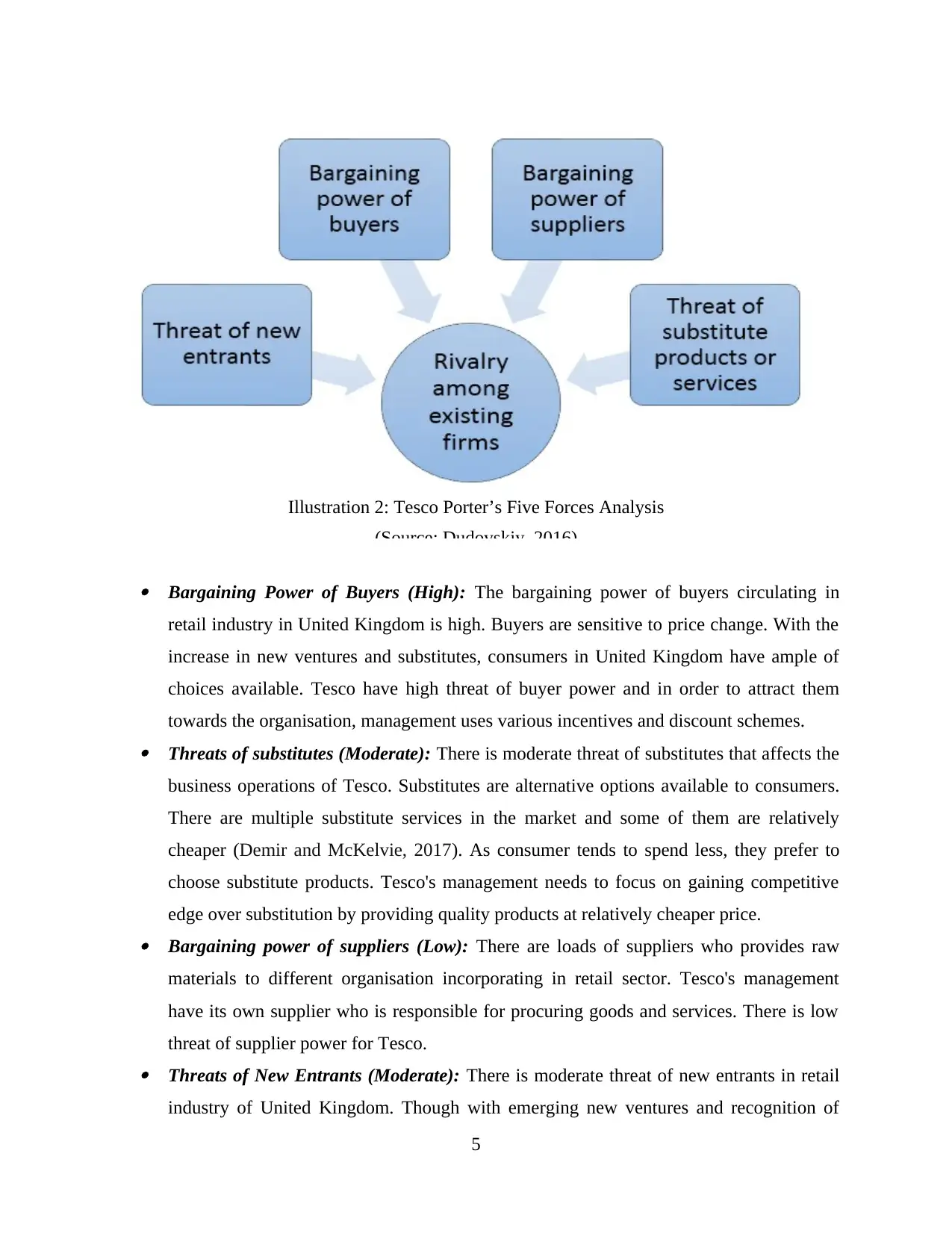
Bargaining Power of Buyers (High): The bargaining power of buyers circulating in
retail industry in United Kingdom is high. Buyers are sensitive to price change. With the
increase in new ventures and substitutes, consumers in United Kingdom have ample of
choices available. Tesco have high threat of buyer power and in order to attract them
towards the organisation, management uses various incentives and discount schemes. Threats of substitutes (Moderate): There is moderate threat of substitutes that affects the
business operations of Tesco. Substitutes are alternative options available to consumers.
There are multiple substitute services in the market and some of them are relatively
cheaper (Demir and McKelvie, 2017). As consumer tends to spend less, they prefer to
choose substitute products. Tesco's management needs to focus on gaining competitive
edge over substitution by providing quality products at relatively cheaper price. Bargaining power of suppliers (Low): There are loads of suppliers who provides raw
materials to different organisation incorporating in retail sector. Tesco's management
have its own supplier who is responsible for procuring goods and services. There is low
threat of supplier power for Tesco. Threats of New Entrants (Moderate): There is moderate threat of new entrants in retail
industry of United Kingdom. Though with emerging new ventures and recognition of
5
Illustration 2: Tesco Porter’s Five Forces Analysis
(Source: Dudovskiy, 2016)
retail industry in United Kingdom is high. Buyers are sensitive to price change. With the
increase in new ventures and substitutes, consumers in United Kingdom have ample of
choices available. Tesco have high threat of buyer power and in order to attract them
towards the organisation, management uses various incentives and discount schemes. Threats of substitutes (Moderate): There is moderate threat of substitutes that affects the
business operations of Tesco. Substitutes are alternative options available to consumers.
There are multiple substitute services in the market and some of them are relatively
cheaper (Demir and McKelvie, 2017). As consumer tends to spend less, they prefer to
choose substitute products. Tesco's management needs to focus on gaining competitive
edge over substitution by providing quality products at relatively cheaper price. Bargaining power of suppliers (Low): There are loads of suppliers who provides raw
materials to different organisation incorporating in retail sector. Tesco's management
have its own supplier who is responsible for procuring goods and services. There is low
threat of supplier power for Tesco. Threats of New Entrants (Moderate): There is moderate threat of new entrants in retail
industry of United Kingdom. Though with emerging new ventures and recognition of
5
Illustration 2: Tesco Porter’s Five Forces Analysis
(Source: Dudovskiy, 2016)
Paraphrase This Document
Need a fresh take? Get an instant paraphrase of this document with our AI Paraphraser
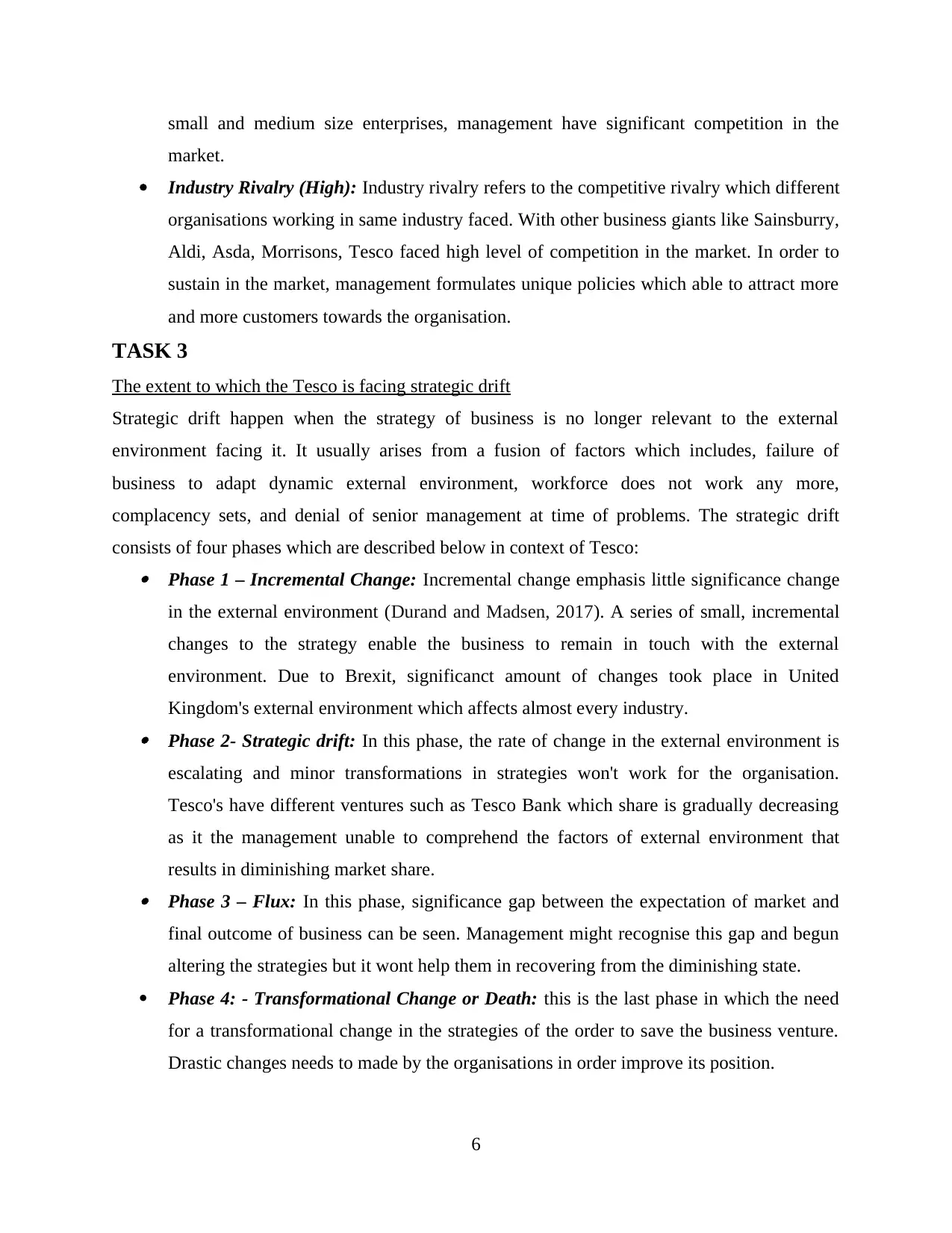
small and medium size enterprises, management have significant competition in the
market.
Industry Rivalry (High): Industry rivalry refers to the competitive rivalry which different
organisations working in same industry faced. With other business giants like Sainsburry,
Aldi, Asda, Morrisons, Tesco faced high level of competition in the market. In order to
sustain in the market, management formulates unique policies which able to attract more
and more customers towards the organisation.
TASK 3
The extent to which the Tesco is facing strategic drift
Strategic drift happen when the strategy of business is no longer relevant to the external
environment facing it. It usually arises from a fusion of factors which includes, failure of
business to adapt dynamic external environment, workforce does not work any more,
complacency sets, and denial of senior management at time of problems. The strategic drift
consists of four phases which are described below in context of Tesco: Phase 1 – Incremental Change: Incremental change emphasis little significance change
in the external environment (Durand and Madsen, 2017). A series of small, incremental
changes to the strategy enable the business to remain in touch with the external
environment. Due to Brexit, significanct amount of changes took place in United
Kingdom's external environment which affects almost every industry. Phase 2- Strategic drift: In this phase, the rate of change in the external environment is
escalating and minor transformations in strategies won't work for the organisation.
Tesco's have different ventures such as Tesco Bank which share is gradually decreasing
as it the management unable to comprehend the factors of external environment that
results in diminishing market share. Phase 3 – Flux: In this phase, significance gap between the expectation of market and
final outcome of business can be seen. Management might recognise this gap and begun
altering the strategies but it wont help them in recovering from the diminishing state.
Phase 4: - Transformational Change or Death: this is the last phase in which the need
for a transformational change in the strategies of the order to save the business venture.
Drastic changes needs to made by the organisations in order improve its position.
6
market.
Industry Rivalry (High): Industry rivalry refers to the competitive rivalry which different
organisations working in same industry faced. With other business giants like Sainsburry,
Aldi, Asda, Morrisons, Tesco faced high level of competition in the market. In order to
sustain in the market, management formulates unique policies which able to attract more
and more customers towards the organisation.
TASK 3
The extent to which the Tesco is facing strategic drift
Strategic drift happen when the strategy of business is no longer relevant to the external
environment facing it. It usually arises from a fusion of factors which includes, failure of
business to adapt dynamic external environment, workforce does not work any more,
complacency sets, and denial of senior management at time of problems. The strategic drift
consists of four phases which are described below in context of Tesco: Phase 1 – Incremental Change: Incremental change emphasis little significance change
in the external environment (Durand and Madsen, 2017). A series of small, incremental
changes to the strategy enable the business to remain in touch with the external
environment. Due to Brexit, significanct amount of changes took place in United
Kingdom's external environment which affects almost every industry. Phase 2- Strategic drift: In this phase, the rate of change in the external environment is
escalating and minor transformations in strategies won't work for the organisation.
Tesco's have different ventures such as Tesco Bank which share is gradually decreasing
as it the management unable to comprehend the factors of external environment that
results in diminishing market share. Phase 3 – Flux: In this phase, significance gap between the expectation of market and
final outcome of business can be seen. Management might recognise this gap and begun
altering the strategies but it wont help them in recovering from the diminishing state.
Phase 4: - Transformational Change or Death: this is the last phase in which the need
for a transformational change in the strategies of the order to save the business venture.
Drastic changes needs to made by the organisations in order improve its position.
6
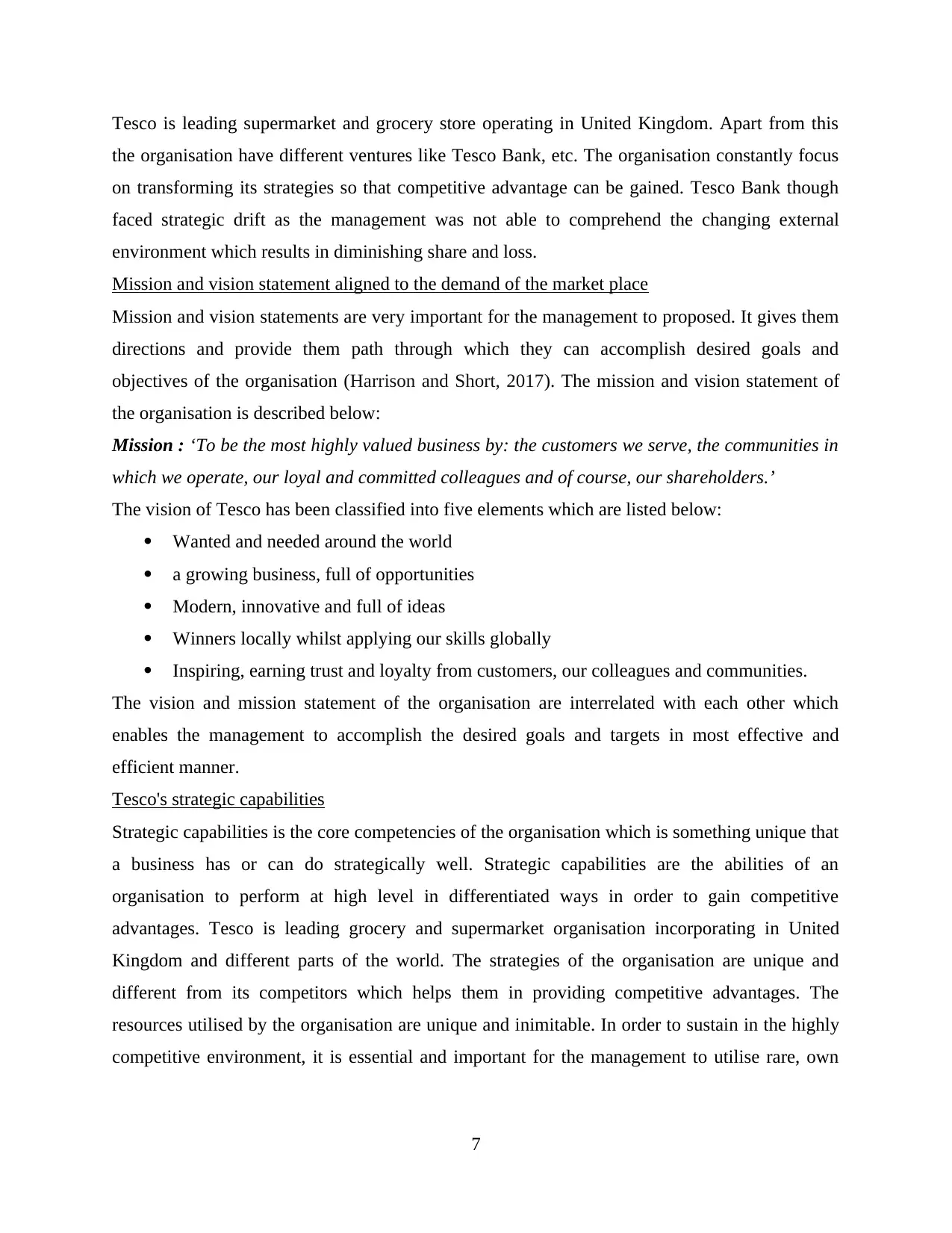
Tesco is leading supermarket and grocery store operating in United Kingdom. Apart from this
the organisation have different ventures like Tesco Bank, etc. The organisation constantly focus
on transforming its strategies so that competitive advantage can be gained. Tesco Bank though
faced strategic drift as the management was not able to comprehend the changing external
environment which results in diminishing share and loss.
Mission and vision statement aligned to the demand of the market place
Mission and vision statements are very important for the management to proposed. It gives them
directions and provide them path through which they can accomplish desired goals and
objectives of the organisation (Harrison and Short, 2017). The mission and vision statement of
the organisation is described below:
Mission : ‘To be the most highly valued business by: the customers we serve, the communities in
which we operate, our loyal and committed colleagues and of course, our shareholders.’
The vision of Tesco has been classified into five elements which are listed below:
Wanted and needed around the world
a growing business, full of opportunities
Modern, innovative and full of ideas
Winners locally whilst applying our skills globally
Inspiring, earning trust and loyalty from customers, our colleagues and communities.
The vision and mission statement of the organisation are interrelated with each other which
enables the management to accomplish the desired goals and targets in most effective and
efficient manner.
Tesco's strategic capabilities
Strategic capabilities is the core competencies of the organisation which is something unique that
a business has or can do strategically well. Strategic capabilities are the abilities of an
organisation to perform at high level in differentiated ways in order to gain competitive
advantages. Tesco is leading grocery and supermarket organisation incorporating in United
Kingdom and different parts of the world. The strategies of the organisation are unique and
different from its competitors which helps them in providing competitive advantages. The
resources utilised by the organisation are unique and inimitable. In order to sustain in the highly
competitive environment, it is essential and important for the management to utilise rare, own
7
the organisation have different ventures like Tesco Bank, etc. The organisation constantly focus
on transforming its strategies so that competitive advantage can be gained. Tesco Bank though
faced strategic drift as the management was not able to comprehend the changing external
environment which results in diminishing share and loss.
Mission and vision statement aligned to the demand of the market place
Mission and vision statements are very important for the management to proposed. It gives them
directions and provide them path through which they can accomplish desired goals and
objectives of the organisation (Harrison and Short, 2017). The mission and vision statement of
the organisation is described below:
Mission : ‘To be the most highly valued business by: the customers we serve, the communities in
which we operate, our loyal and committed colleagues and of course, our shareholders.’
The vision of Tesco has been classified into five elements which are listed below:
Wanted and needed around the world
a growing business, full of opportunities
Modern, innovative and full of ideas
Winners locally whilst applying our skills globally
Inspiring, earning trust and loyalty from customers, our colleagues and communities.
The vision and mission statement of the organisation are interrelated with each other which
enables the management to accomplish the desired goals and targets in most effective and
efficient manner.
Tesco's strategic capabilities
Strategic capabilities is the core competencies of the organisation which is something unique that
a business has or can do strategically well. Strategic capabilities are the abilities of an
organisation to perform at high level in differentiated ways in order to gain competitive
advantages. Tesco is leading grocery and supermarket organisation incorporating in United
Kingdom and different parts of the world. The strategies of the organisation are unique and
different from its competitors which helps them in providing competitive advantages. The
resources utilised by the organisation are unique and inimitable. In order to sustain in the highly
competitive environment, it is essential and important for the management to utilise rare, own
7
⊘ This is a preview!⊘
Do you want full access?
Subscribe today to unlock all pages.

Trusted by 1+ million students worldwide
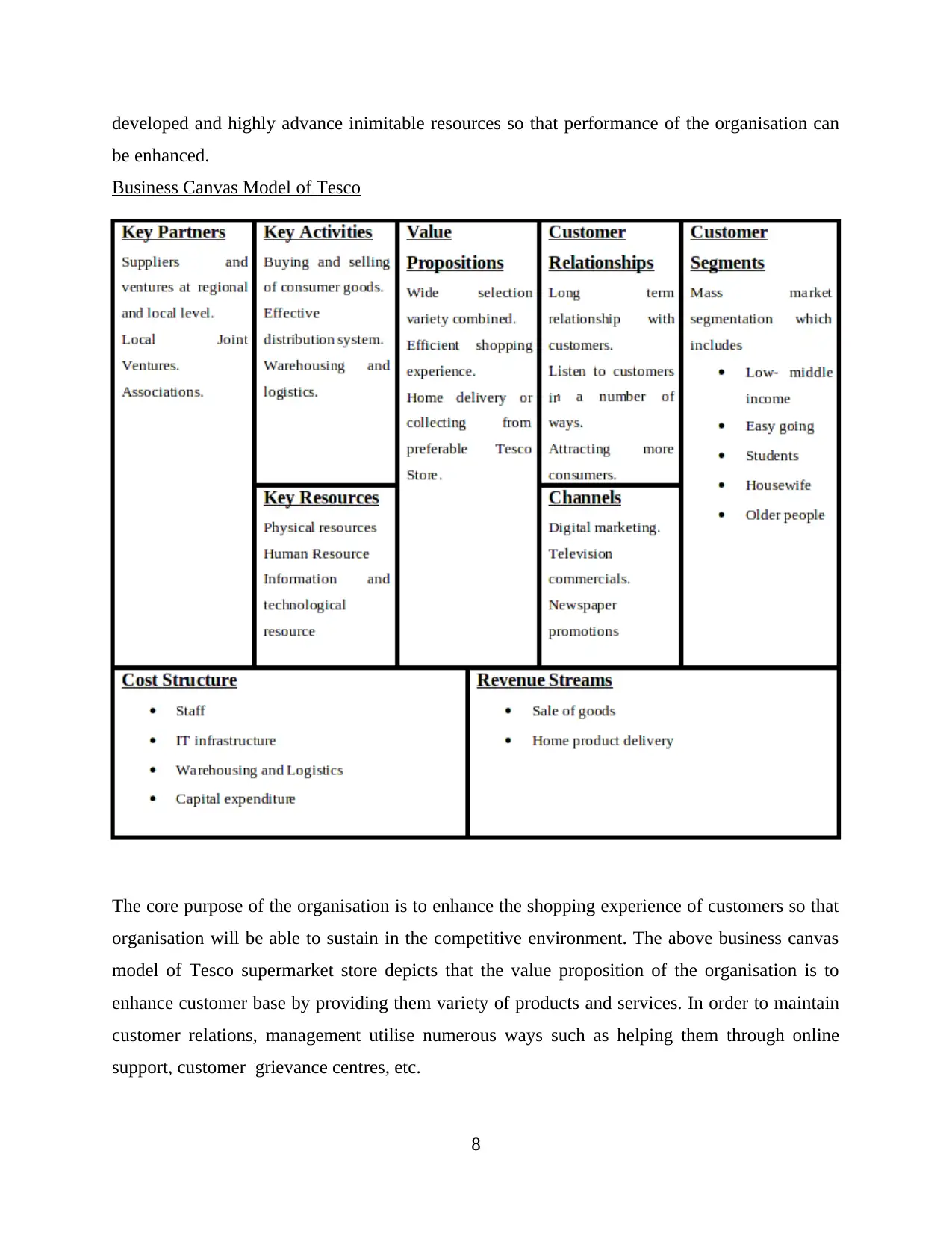
developed and highly advance inimitable resources so that performance of the organisation can
be enhanced.
Business Canvas Model of Tesco
The core purpose of the organisation is to enhance the shopping experience of customers so that
organisation will be able to sustain in the competitive environment. The above business canvas
model of Tesco supermarket store depicts that the value proposition of the organisation is to
enhance customer base by providing them variety of products and services. In order to maintain
customer relations, management utilise numerous ways such as helping them through online
support, customer grievance centres, etc.
8
be enhanced.
Business Canvas Model of Tesco
The core purpose of the organisation is to enhance the shopping experience of customers so that
organisation will be able to sustain in the competitive environment. The above business canvas
model of Tesco supermarket store depicts that the value proposition of the organisation is to
enhance customer base by providing them variety of products and services. In order to maintain
customer relations, management utilise numerous ways such as helping them through online
support, customer grievance centres, etc.
8
Paraphrase This Document
Need a fresh take? Get an instant paraphrase of this document with our AI Paraphraser
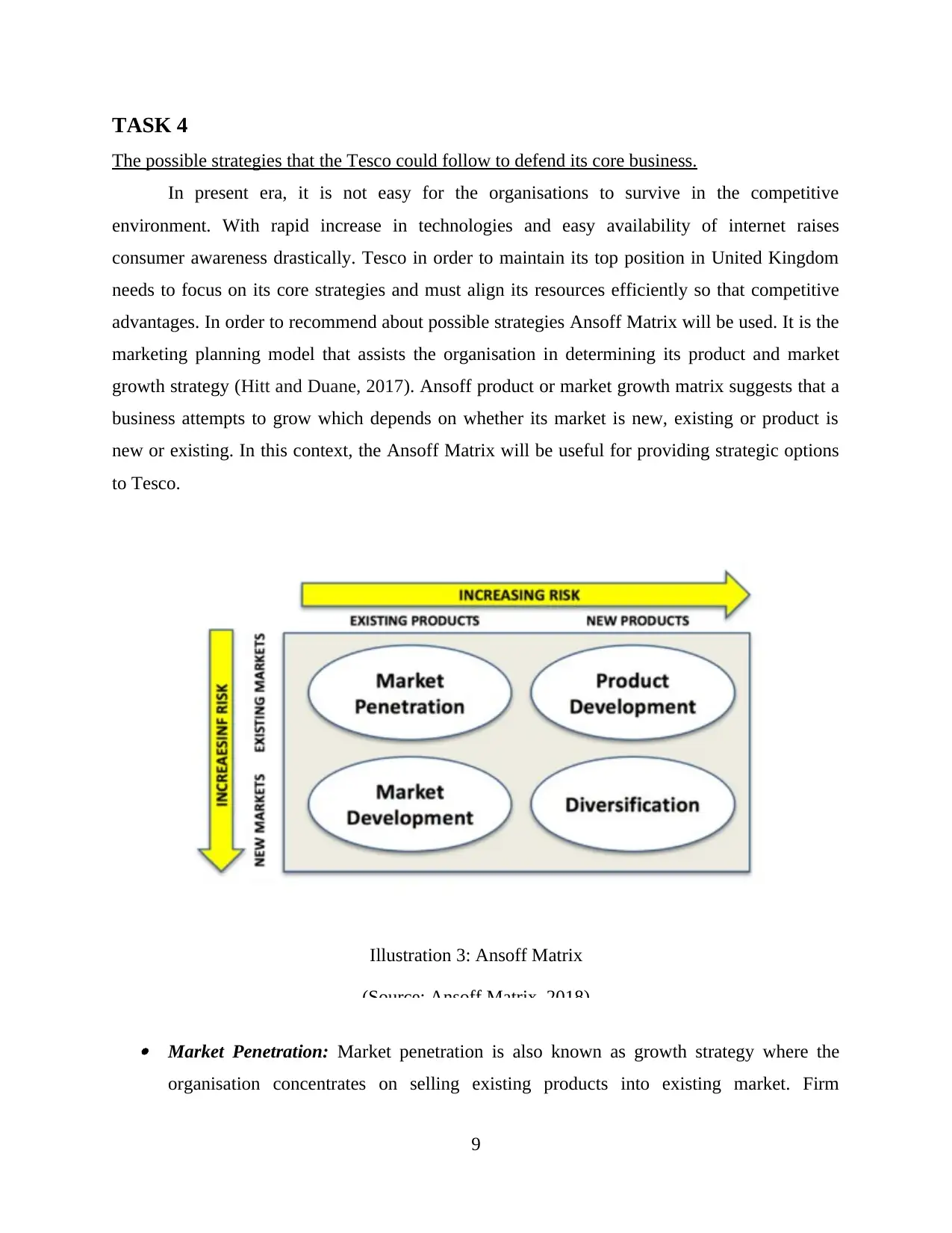
TASK 4
The possible strategies that the Tesco could follow to defend its core business.
In present era, it is not easy for the organisations to survive in the competitive
environment. With rapid increase in technologies and easy availability of internet raises
consumer awareness drastically. Tesco in order to maintain its top position in United Kingdom
needs to focus on its core strategies and must align its resources efficiently so that competitive
advantages. In order to recommend about possible strategies Ansoff Matrix will be used. It is the
marketing planning model that assists the organisation in determining its product and market
growth strategy (Hitt and Duane, 2017). Ansoff product or market growth matrix suggests that a
business attempts to grow which depends on whether its market is new, existing or product is
new or existing. In this context, the Ansoff Matrix will be useful for providing strategic options
to Tesco.
Market Penetration: Market penetration is also known as growth strategy where the
organisation concentrates on selling existing products into existing market. Firm
9
Illustration 3: Ansoff Matrix
(Source: Ansoff Matrix, 2018)
The possible strategies that the Tesco could follow to defend its core business.
In present era, it is not easy for the organisations to survive in the competitive
environment. With rapid increase in technologies and easy availability of internet raises
consumer awareness drastically. Tesco in order to maintain its top position in United Kingdom
needs to focus on its core strategies and must align its resources efficiently so that competitive
advantages. In order to recommend about possible strategies Ansoff Matrix will be used. It is the
marketing planning model that assists the organisation in determining its product and market
growth strategy (Hitt and Duane, 2017). Ansoff product or market growth matrix suggests that a
business attempts to grow which depends on whether its market is new, existing or product is
new or existing. In this context, the Ansoff Matrix will be useful for providing strategic options
to Tesco.
Market Penetration: Market penetration is also known as growth strategy where the
organisation concentrates on selling existing products into existing market. Firm
9
Illustration 3: Ansoff Matrix
(Source: Ansoff Matrix, 2018)
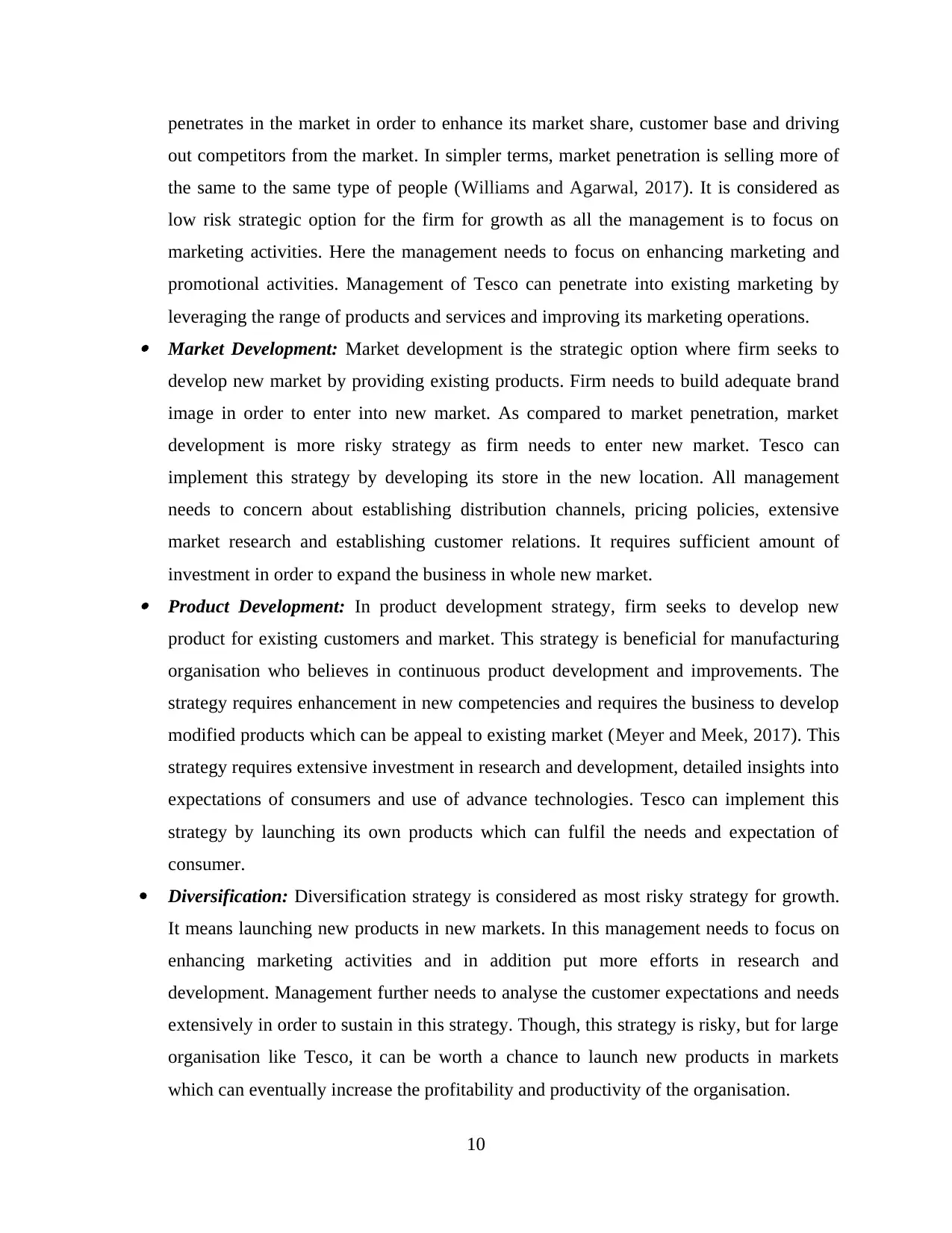
penetrates in the market in order to enhance its market share, customer base and driving
out competitors from the market. In simpler terms, market penetration is selling more of
the same to the same type of people (Williams and Agarwal, 2017). It is considered as
low risk strategic option for the firm for growth as all the management is to focus on
marketing activities. Here the management needs to focus on enhancing marketing and
promotional activities. Management of Tesco can penetrate into existing marketing by
leveraging the range of products and services and improving its marketing operations. Market Development: Market development is the strategic option where firm seeks to
develop new market by providing existing products. Firm needs to build adequate brand
image in order to enter into new market. As compared to market penetration, market
development is more risky strategy as firm needs to enter new market. Tesco can
implement this strategy by developing its store in the new location. All management
needs to concern about establishing distribution channels, pricing policies, extensive
market research and establishing customer relations. It requires sufficient amount of
investment in order to expand the business in whole new market. Product Development: In product development strategy, firm seeks to develop new
product for existing customers and market. This strategy is beneficial for manufacturing
organisation who believes in continuous product development and improvements. The
strategy requires enhancement in new competencies and requires the business to develop
modified products which can be appeal to existing market (Meyer and Meek, 2017). This
strategy requires extensive investment in research and development, detailed insights into
expectations of consumers and use of advance technologies. Tesco can implement this
strategy by launching its own products which can fulfil the needs and expectation of
consumer.
Diversification: Diversification strategy is considered as most risky strategy for growth.
It means launching new products in new markets. In this management needs to focus on
enhancing marketing activities and in addition put more efforts in research and
development. Management further needs to analyse the customer expectations and needs
extensively in order to sustain in this strategy. Though, this strategy is risky, but for large
organisation like Tesco, it can be worth a chance to launch new products in markets
which can eventually increase the profitability and productivity of the organisation.
10
out competitors from the market. In simpler terms, market penetration is selling more of
the same to the same type of people (Williams and Agarwal, 2017). It is considered as
low risk strategic option for the firm for growth as all the management is to focus on
marketing activities. Here the management needs to focus on enhancing marketing and
promotional activities. Management of Tesco can penetrate into existing marketing by
leveraging the range of products and services and improving its marketing operations. Market Development: Market development is the strategic option where firm seeks to
develop new market by providing existing products. Firm needs to build adequate brand
image in order to enter into new market. As compared to market penetration, market
development is more risky strategy as firm needs to enter new market. Tesco can
implement this strategy by developing its store in the new location. All management
needs to concern about establishing distribution channels, pricing policies, extensive
market research and establishing customer relations. It requires sufficient amount of
investment in order to expand the business in whole new market. Product Development: In product development strategy, firm seeks to develop new
product for existing customers and market. This strategy is beneficial for manufacturing
organisation who believes in continuous product development and improvements. The
strategy requires enhancement in new competencies and requires the business to develop
modified products which can be appeal to existing market (Meyer and Meek, 2017). This
strategy requires extensive investment in research and development, detailed insights into
expectations of consumers and use of advance technologies. Tesco can implement this
strategy by launching its own products which can fulfil the needs and expectation of
consumer.
Diversification: Diversification strategy is considered as most risky strategy for growth.
It means launching new products in new markets. In this management needs to focus on
enhancing marketing activities and in addition put more efforts in research and
development. Management further needs to analyse the customer expectations and needs
extensively in order to sustain in this strategy. Though, this strategy is risky, but for large
organisation like Tesco, it can be worth a chance to launch new products in markets
which can eventually increase the profitability and productivity of the organisation.
10
⊘ This is a preview!⊘
Do you want full access?
Subscribe today to unlock all pages.

Trusted by 1+ million students worldwide
1 out of 19
Related Documents
Your All-in-One AI-Powered Toolkit for Academic Success.
+13062052269
info@desklib.com
Available 24*7 on WhatsApp / Email
![[object Object]](/_next/static/media/star-bottom.7253800d.svg)
Unlock your academic potential
Copyright © 2020–2025 A2Z Services. All Rights Reserved. Developed and managed by ZUCOL.




